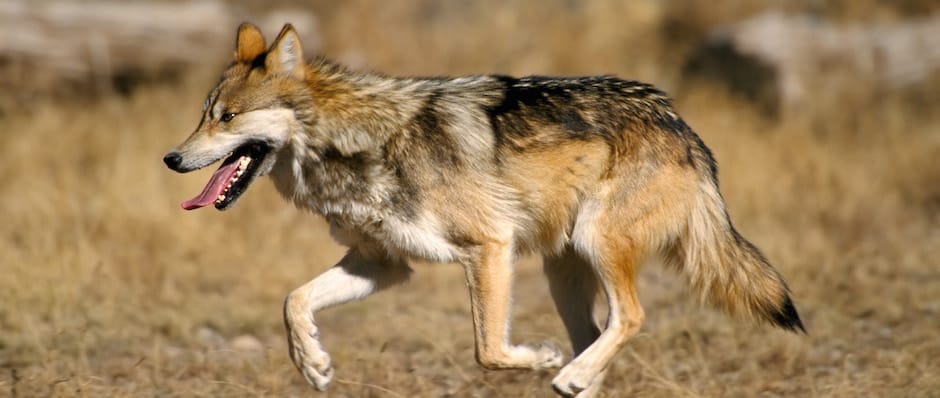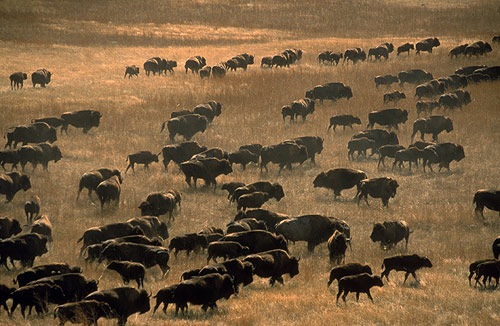Returning the Wolf to Texas

The Mexican Wolf would be highly beneficial to West Texas wildlife, habitats, and cattle raising.
NOTE: Post Originally Appeared on Rick Libello’s site on March 14, 2015
Less than a 100 yards from my office at the El Paso Zoo every day I am reminded of one of the most important missing links in the Chihuahuan Desert ecoregion, a wild predator that we all know as a symbol of wilderness and as an important apex predator, the gray wolf or Mexican wolf (Canis lupus baileyi).
Prior to moving to El Paso I was active in wolf restoration efforts in Texas during the 1990s when the Sierra Club and other environmental groups helped to gain public support for the return of wolves to the Southwest at the Apache National Forest of eastern Arizona. I was greatly encouraged when I was asked to serve on the EXCOM of the El Paso Sierra Club Group that our chair, Laurence Gibson, had Texas wolf restoration on his radar screen. On March 18, 2015 we are launching a new “Return of the Wolf to Texas Education Initiative” at a Rubin Center on the UTEP campus at 6pm.
Prior to the war against the wolf that started in the 1800s and ended around the middle of the last century; wolves once roamed a large area of West Texas including the Davis Mountains region and the area now called Big Bend National Park. Unlike the black bear that survived in great enough numbers in Mexico to eventually repopulate parts of West Texas during the 1980s, wolf extermination efforts resulted in the extinction of the wolf in Texas about the same time it was declared endangered (March 11, 1967). The last two wolves known to Texas were killed in 1970 when one was shot from the Cathedral Mountain Ranch south of Alpine and another trapped from the Joe Neal Brown Ranch located at the point where Brewster, Pecos, and Terrell counties meet.
Today we can learn much about the importance of wolves to the ecosystem by paying close attention to what is happening in places where they made a comeback. Predators like the wolf provide important ecological services in helping to control prey species like elk in Yellowstone National Park. If elk become too numerous, they can prevent the growth of certain plants. These plants, if not allowed to grow, can affect nesting sites for birds and food that other animals need to survive. Yellowstone illustrates a great example of the ecological value of wolves where their return has helped to restore willow trees, beaver and other species in the Lamar Valley.
The return of wolves to Yellowstone has also had a tremendous impact on the surrounding area’s economy. A study led by University of Montana economist John Duffield showed that visitors who come to Yellowstone to see wolves contribute roughly $35.5 million annually to the regional economy. Anyone in West Texas looking to see the economy improve?
In a letter to former Regional Director Michael Spear of the US Fish and Wildlife Service on August 8, 1986, Charles Travis, the Executive Director of Texas Parks and Wildlife Department, summarized his opposition to returning the wolf in Texas by saying “there is already a history of conflict between stockman and the federal government in both of these areas (Guadalupe Mountains and Big Bend National Parks) concerning mountain lions that appear to range out of the park and kill stock on surrounding land. It is unlikely that Mexican wolves would be viewed any differently and these areas have limited suitability for that reason.”
Many people believe that Travis’s arguments in opposing wolf restoration are still valid today. Perhaps not, many of the large land owners who opposed predators like wolves and mountain lions are no longer with us or have sold their land to people from cities who appreciate protecting the environment as it naturally occurred prior to the first Europeans coming to America. As long as there are optimists like myself, I hope that someday we will prove them wrong. Let’s hope for the sake of wilderness and the future of humanity that the wolf will be given the chance to reclaim its rightful role in the Chihuahuan Desert. Imagine, the return of the “Grand Opera of Texas” to the dark skies of Texas. Imagine, the return of the gray wolf.
When I read this excellent piece I wrote Rick the following letter:
APRIL 4, 2015
Dear Rick,
I have just visited your website and read the wolf piece. I am in complete agreement and have written several pieces along these lines in the Circle Ranch blog.
I would like to amplify on one of your comments. The importance of predators goes beyond controlling animal numbers. In Yellowstone Park the beneficial effect on habitat caused by wolves mostly had to do with the way that they change the behavior of elk in riparian areas. When wolves are absent, elk spend most of their time on the river banks where they eat the baby aspen and harm the plants that keep the riverbank stable. But when there are wolves about, they will ambush these elk in the heavy cover that is found near rivers. So now elk come to the river, drink and leave for safer territory. This allows riparian areas the relief they need to recover: Behavior of wildlife was changed in ways that helped habitat.
The reason bison stayed in tightly bunched herds, constantly moving while delivering beneficial animal impact, was because they were surrounded by pack hunting predators. This is the same story with wildebeest today on the grasslands of East Africa. Again, predators shape animal behavior in ways that help habitat.
We are cattle ranchers and we run our cattle in a way that mimics these concentrated herds, constantly moving and with long recovery periods between grazing. Anti-wolf ranchers generally do not realize that when you concentrate your herds they become relatively safe from wolves, as new research has shown.
Cattle, horses, deer or predators can all be a nuisance. But we have engineered our ranches to deal with these. We can do the same thing with wolves. What is important for ranchers to understand is that cattle habitat will improve as a result of restoring predators and animal diversity, so long as grazing practices imitate nature.
And obviously, predators including wolves will cull sick and old animals far better than any wildlife “manager”. Think of mule deer and Chronic Wasting Disease (CWD) in El Paso County.
Circle Ranch would like to be part of your effort. Let me know how we can help.
Sincerely,
Christopher Gill
Circle Ranch
Van Horn Texas



